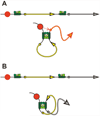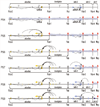The boundary paradox in the Bithorax complex
- PMID: 26215349
- PMCID: PMC4890074
- DOI: 10.1016/j.mod.2015.07.002
The boundary paradox in the Bithorax complex
Abstract
The parasegment-specific expression of the three Drosophila Bithorax complex homeotic genes is orchestrated by nine functionally autonomous regulatory domains. Functional autonomy depends upon special elements called boundaries or insulators that are located between each domain. The boundaries ensure the independent activity of each domain by blocking adventitious interactions with initiators, enhancers and silencers in the neighboring domains. However, this blocking activity poses a regulatory paradox--the Bithorax boundaries are also able to insulate promoters from regulatory interactions with enhancers and silencers and six of the nine Bithorax regulatory domains are separated from their target genes by at least one boundary element. Here we consider several mechanisms that have been suggested for how the Bithorax regulatory domains are able to bypass intervening boundary elements and direct the appropriate parasegment-specific temporal and spatial expression of their target gene.
Keywords: Bithorax complex; Boundary bypass; Boundary element; Enhancer blocking; Insulator.
Copyright © 2015 Elsevier Ireland Ltd. All rights reserved.
Figures






Similar articles
-
Functional Dissection of the Blocking and Bypass Activities of the Fab-8 Boundary in the Drosophila Bithorax Complex.PLoS Genet. 2016 Jul 18;12(7):e1006188. doi: 10.1371/journal.pgen.1006188. eCollection 2016 Jul. PLoS Genet. 2016. PMID: 27428541 Free PMC article.
-
Boundaries mediate long-distance interactions between enhancers and promoters in the Drosophila Bithorax complex.PLoS Genet. 2018 Dec 12;14(12):e1007702. doi: 10.1371/journal.pgen.1007702. eCollection 2018 Dec. PLoS Genet. 2018. PMID: 30540750 Free PMC article.
-
Chromatin insulators and long-distance interactions in Drosophila.FEBS Lett. 2014 Jan 3;588(1):8-14. doi: 10.1016/j.febslet.2013.10.039. Epub 2013 Nov 5. FEBS Lett. 2014. PMID: 24211836 Review.
-
The bithorax complex iab-7 Polycomb response element has a novel role in the functioning of the Fab-7 chromatin boundary.PLoS Genet. 2018 Aug 15;14(8):e1007442. doi: 10.1371/journal.pgen.1007442. eCollection 2018 Aug. PLoS Genet. 2018. PMID: 30110328 Free PMC article.
-
Unraveling cis-regulatory mechanisms at the abdominal-A and Abdominal-B genes in the Drosophila bithorax complex.Dev Biol. 2006 May 15;293(2):294-304. doi: 10.1016/j.ydbio.2006.02.015. Epub 2006 Mar 20. Dev Biol. 2006. PMID: 16545794 Review.
Cited by
-
Evolution of Regulated Transcription.Cells. 2020 Jul 12;9(7):1675. doi: 10.3390/cells9071675. Cells. 2020. PMID: 32664620 Free PMC article. Review.
-
Visualizing DNA folding and RNA in embryos at single-cell resolution.Nature. 2019 Apr;568(7750):49-54. doi: 10.1038/s41586-019-1035-4. Epub 2019 Mar 18. Nature. 2019. PMID: 30886393 Free PMC article.
-
Homeotic Genes: Clustering, Modularity, and Diversity.Front Cell Dev Biol. 2021 Aug 11;9:718308. doi: 10.3389/fcell.2021.718308. eCollection 2021. Front Cell Dev Biol. 2021. PMID: 34458272 Free PMC article. Review.
-
Functional Dissection of the Blocking and Bypass Activities of the Fab-8 Boundary in the Drosophila Bithorax Complex.PLoS Genet. 2016 Jul 18;12(7):e1006188. doi: 10.1371/journal.pgen.1006188. eCollection 2016 Jul. PLoS Genet. 2016. PMID: 27428541 Free PMC article.
-
Functional dissection of the developmentally restricted BEN domain chromatin boundary factor Insensitive.Epigenetics Chromatin. 2019 Jan 3;12(1):2. doi: 10.1186/s13072-018-0249-2. Epigenetics Chromatin. 2019. PMID: 30602385 Free PMC article.
References
-
- Barges S, Mihaly J, Galloni M, Hagstrom K, Müller M, Shanower G, Schedl P, Gyurkovics H, Karch F. The Fab-8 boundary defines the distal limit of the bithorax complex iab-7 domain and insulates iab-7 from initiation elements and a PRE in the adjacent iab-8 domain. Dev. Camb. Engl. 2000;127:779–790. - PubMed
-
- Beachy PA, Helfand SL, Hogness DS. Segmental distribution of bithorax complex proteins during Drosophila development. Nature. 1985;313:545–551. - PubMed
-
- Bender W, Akam M, Karch F, Beachy PA, Peifer M, Spierer P, Lewis EB, Hogness DS. Molecular Genetics of the Bithorax Complex in Drosophila melanogaster. Science. 1983;221:23–29. - PubMed
-
- Bender W, Hudson A. P element homing to the Drosophila bithorax complex. Dev. Camb. Engl. 2000;127:3981–3992. - PubMed
Publication types
MeSH terms
Substances
Grants and funding
LinkOut - more resources
Full Text Sources
Other Literature Sources
Molecular Biology Databases

